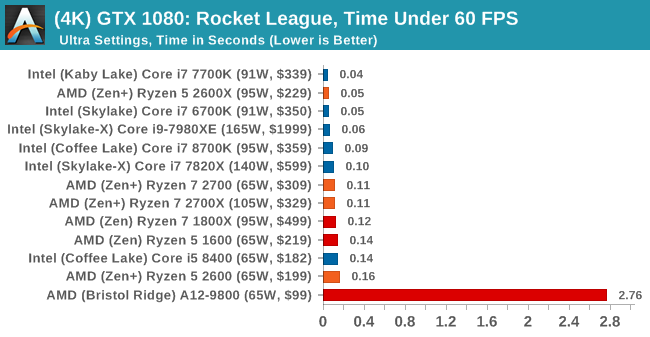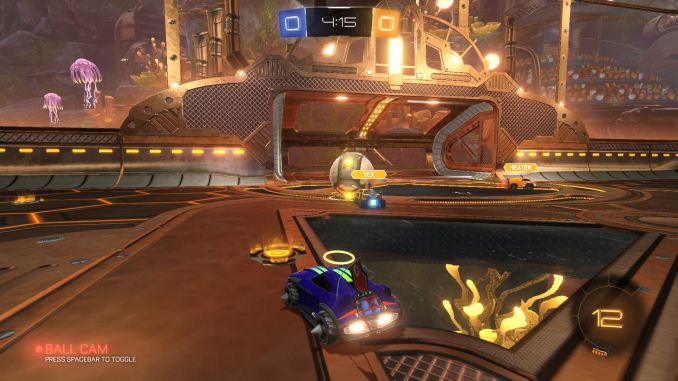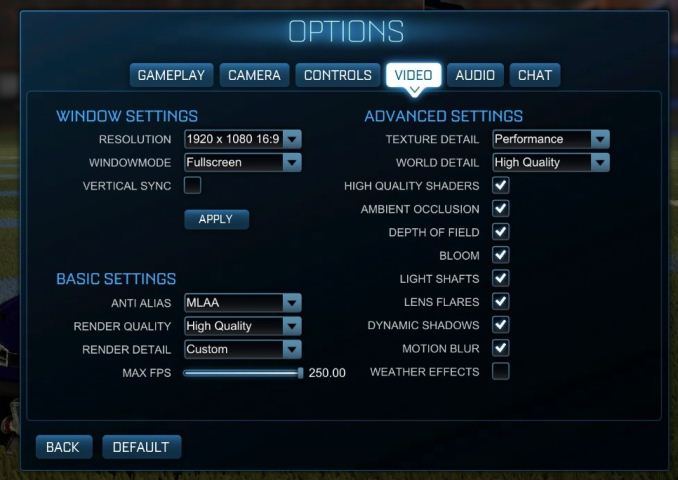The AMD 2nd Gen Ryzen Deep Dive: The 2700X, 2700, 2600X, and 2600 Tested
by Ian Cutress on April 19, 2018 9:00 AM ESTRocket League
Hilariously simple pick-up-and-play games are great fun. I'm a massive fan of the Katamari franchise for that reason — passing start on a controller and rolling around, picking up things to get bigger, is extremely simple. Until we get a PC version of Katamari that I can benchmark, we'll focus on Rocket League.
Rocket League combines the elements of pick-up-and-play, allowing users to jump into a game with other people (or bots) to play football with cars with zero rules. The title is built on Unreal Engine 3, which is somewhat old at this point, but it allows users to run the game on super-low-end systems while still taxing the big ones. Since the release in 2015, it has sold over 5 million copies and seems to be a fixture at LANs and game shows. Users who train get very serious, playing in teams and leagues with very few settings to configure, and everyone is on the same level. Rocket League is quickly becoming one of the favored titles for e-sports tournaments, especially when e-sports contests can be viewed directly from the game interface.
Based on these factors, plus the fact that it is an extremely fun title to load and play, we set out to find the best way to benchmark it. Unfortunately for the most part automatic benchmark modes for games are few and far between. Partly because of this, but also on the basis that it is built on the Unreal 3 engine, Rocket League does not have a benchmark mode. In this case, we have to develop a consistent run and record the frame rate.
Read our initial analysis on our Rocket League benchmark on low-end graphics here.
With Rocket League, there is no benchmark mode, so we have to perform a series of automated actions, similar to a racing game having a fixed number of laps. We take the following approach: Using Fraps to record the time taken to show each frame (and the overall frame rates), we use an automation tool to set up a consistent no-bot match on easy, with the system applying a series of inputs throughout the run, such as switching camera angles and driving around.
It turns out that this method is nicely indicative of a real match, driving up walls, boosting and even putting in the odd assist, save and/or goal, as weird as that sounds for an automated set of commands. To maintain consistency, the commands we apply are not random but time-fixed, and we also keep the map the same (Aquadome, known to be a tough map for GPUs due to water/transparency) and the car customization constant. We start recording just after a match starts, and record for 4 minutes of game time (think 5 laps of a DIRT: Rally benchmark), with average frame rates, 99th percentile and frame times all provided.
The graphics settings for Rocket League come in four broad, generic settings: Low, Medium, High and High FXAA. There are advanced settings in place for shadows and details; however, for these tests, we keep to the generic settings. For both 1920x1080 and 4K resolutions, we test at the High preset with an unlimited frame cap.
All of our benchmark results can also be found in our benchmark engine, Bench.
MSI GTX 1080 Gaming 8G Performance
1080p



4K
















545 Comments
View All Comments
Santoval - Thursday, April 19, 2018 - link
It's possible that the first consumer Intel 8-core will be based on Ice Lake. Cannon Lake will probably largely limited to low power CPUs, and will probably top out at 4 cores. Of course if Ice Lake is delayed again Intel might scale out Cannon Lake to more cores. Cannon Lake will be just a 10nm node of the Skylake/Kaby/Coffee Lake architecture, so it will most likely provide mostly power efficiency gains.aliquis - Thursday, April 19, 2018 - link
Latest road map show coffee lake refresh in Q4.mahoney87 - Thursday, April 19, 2018 - link
lol :Dhttps://imgur.com/SmJBKkf
They done fecked up
Luckz - Monday, April 23, 2018 - link
Rocket League is a joke game when it comes to benchmarking, optimization and so on.Chris113q - Thursday, April 19, 2018 - link
Do you really need to be spoon-fed information? How long would it take you to find the other reviews by yourself?PCPER, Tweaktown, Toms Hardware, Hothardware, Computerbase all had different results (can't post link due to spam protection). Not to mention you'd have to be totally tech illiterate to believe that stock 2600 can beat 8700k by such a huge margin. Meltdown/Spectre patches don't affect gaming performance that much, so don't you put blame on that.
The result discrepancy is embarrassing, there goes the last speck of reputation Anandtech had as a reliable source of tech news.
MuhOo - Thursday, April 19, 2018 - link
You sir are right.Aegan23 - Thursday, April 19, 2018 - link
You do know who Ian is, right? XDsor - Thursday, April 19, 2018 - link
Anandtech has no responsibility to go out and ensure their results match up with anyone else’s. They run their own selection of tests with their own build and report the numbers. They provide the test setup, if you can’t spot the differences that’s your own issue.Ryan Smith - Thursday, April 19, 2018 - link
"Anandtech has no responsibility to go out and ensure their results match up with anyone else’s"Responsibility? No. But should we anyhow? Yes.
Our responsibility is accuracy. If something looks weird with our data - which it does right now - then it's our job to go back, validate, and explain the results that we're seeing. If our results disagree with other sites, then that is definitely an indication that we may have a data issue.
xidex2 - Thursday, April 19, 2018 - link
I bet none of the other sites applied spectre and meltdown patches for Intel because they dont care about such things. Intel fanboys are now crying because someone actually showed true numbers.